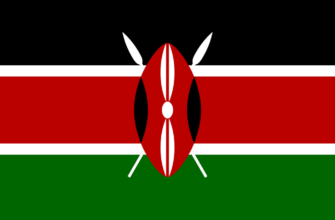Mali is the second largest state in West Africa. It occupies an area of more than 1.4 million km². Until the middle of the XX century, Mali was a French colony, so the official language of the state is French. The capital is the city of Bamako. Mali is a country of deserts and savannahs, which is home to more than 15.3 million people. In this article we will talk about the national flag, its history and meaning.
Bamako, translated from the local Bambara language, means «crocodile river. Crocodiles are in fact countless here, and they are even depicted on the country’s coat of arms.
This is what the modern flag of Mali looks like:

History of the flag
The original symbol of the republic appeared after a referendum in French Sudan on September 28, 1958, in which Mali (at that time still the Sudanese Republic) was recognized as an autonomous state within the French society. The flag was approved on November 24, 1958. It depicted a black man against the background of the French flag.

Afterwards, on April 4, 1959, the Republic of the Sudan and the Republic of Senegal united in Mali, creating their own flag. It replaced the two stripes blue and white with other colors, green and yellow, but still had in the center the ideogram of a man with his hands raised to the sun (Kanaga). Under this flag the independence of the country was recognized. In 1960, Senegal withdrew from Mali. In January 1961 the kanaga was removed from the image of the flag, as the Muslim side did not approve of any depiction of a man. The official law on the adoption of the national symbol, signed by the deputies at the plenary session of the National Assembly is No. 61- 26 of January 20, 1961.

From the 13th to the 17th century, the territories were home to the powerful Empire of Mali. The modern name of the country is a reference to those times.
Description
Rectangular canvas divided into three equal wide strips with no additional images.
Flag colors
Green, yellow (in some sources — gold) and red colors are present.
Meaning of colors and flag symbol
- Green symbolizes agricultural development, soil, green pastures, fertile land and the welfare of the country. It also speaks of hope for development and modernization.
- The yellow stripe speaks of gold and other minerals mined in Mali. The indigenous people of the state are ready to stand up for their wealth and fight for it to the last.
- Red calls to mind the people’s memory of the blood shed on their land. It is also a spur to action if suddenly an enemy nation attacks their country.
- The history of the country is fascinating and demands special attention. Take some time to study the state, and you will learn many new and interesting things for yourself.
General information about Mali
| Official language | French, bamana |
| Capital | Bamako |
| Territory | 1 240 192 km2 |
| Population | 19 329 841 people |
| Currency | CFA franc |
| Phone Code | +233 |










I remember visiting Mali a few years back and seeing their vibrant flag everywhere. Each color represents something special: green for the land, yellow for the wealth, and red for the struggles. It was inspiring to see how proud everyone was of their culture and history.
I once traveled to Mali and was amazed by the vibrant colors of the flag. It reminded me of the beautiful landscapes and the warm people I met there. I’m so grateful for that experience—it truly opened my eyes to a rich culture and history!